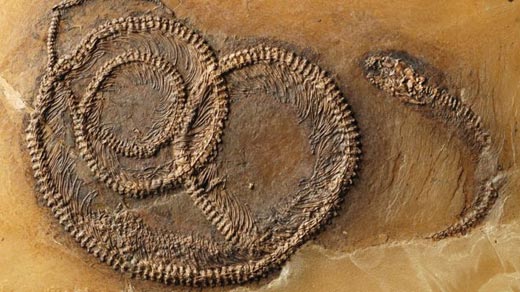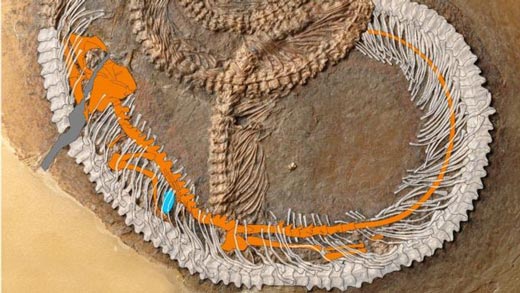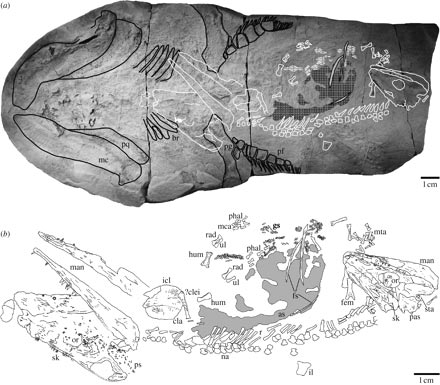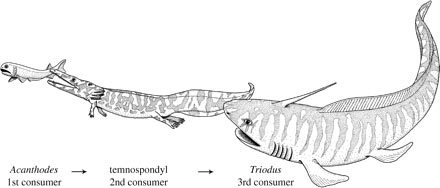The Food Chains of Messel Explored in New Study
Fossil Preserves Snake ate Lizard, Lizard ate Beetle
Scientists from the Senckenberg Museum of Natural History have published a paper on a spectacular fossil from the famous Messel oil shales that shows evidence of a food chain preserved from the Eocene. A fossil snake contains the preserved remains of its last meal, a lizard inside its stomach, astonishingly the exquisite fossil has also preserved evidence of the unfortunate lizard’s last supper too – a beetle. The discovery of a tripartite fossil food chain is unique for this UNESCO World Heritage site and the only other tripartite food chain known in the fossil record dates from the Early Permian*, coincidentally, it also was found in Germany.
Who’s Eating Who? Remarkable Three Party Trophic Chain (Food Web)
Picture credit: Dr. Krister Smith (Senckenberg Museum of Natural History)
A Remarkable Fossil Specimen
Scientists from the Senckenberg Museum of Natural History in collaboration with colleagues from Argentina were able to study this “Russian Doll” of a fossil, that dates from around 48 million years ago and gain new information about the diets of these ancient creatures. For example, the twenty-centimetre-long lizard, identified as Geiseltaliellus maarius, is only known from the Messel shales. Specimens found to date with preserved stomach contents, only had plant remains within the body cavity, this new research indicates that G. maarius was not entirely herbivorous, insects such as beetles were also on the menu.
Commenting on the study, published in the Museum’s scientific journal, Doctor Krister Smith, one of the authors of the paper stated:
“In the year 2009, we were able to recover a plate from the pit that shows an almost fully preserved snake. As if this was not enough, we discovered a fossilised lizard inside the snake, which in turn contained a fossilised beetle in its innards!”
A Magnified View of the Snake Gut with Line Drawings Indicating the Presence of Other Fossil Specimens
Picture credit: Dr. Krister Smith (Senckenberg Museum of Natural History)
The picture above shows the bones of the snake outlined with the lizard shown in orange (skull to the left of the picture), the blue shape in the lizard gut indicates the fossilised remains of the lizard’s last meal- a small beetle. Unfortunately, the scientists were not able to identify the beetle genus. The way in which the lizard remains were overlapped by the ribs of the snake prove that the body of the little reptile was definitely inside the snake when the snake, identified as a type of early constrictor (Palaeopython fischeri), met its own demise.
Visit Everything Dinosaur’s website: Everything Dinosaur.
There was an Old Lady who Swallowed a Fly…
This beautifully preserved fossil specimen reminds team members at Everything Dinosaur of the song “there was an old lady who swallowed a fly”. For the scientists, the Palaeopython specimen provides a new insight into the feeding habits of these Eocene snakes.
The snake fossil measures around 89 centimetres in length, but adult Palaeopythons exceeded two metres in size and they were amongst the largest terrestrial predators known from the Messel shale biota. Just like modern constrictors and pythons, the authors suggest that the diet of these snakes changed as the animals got bigger. The juvenile Palaeopython represented here (specimen number SMF ME 11332), may have fed on small rodents and lizards, whilst the adult snakes may have taken larger vertebrates such as young Propalaeotherium (an ancestral horse).
Based on an assessment of the degree of preservation of the lizard’s remains when compared to digestive speeds in extant snakes, the researchers conclude that the snake died within 48-hours of consuming the lizard. That’s a remarkable insight considering the age of the fossil itself (approximately 48 million-years-old).
The scientific paper: “Fossil Snake Preserving Three Trophic Levels and Evidence for an Ontogenetic Dietary Shift”.
Early Permian Trophic Chains
* The first direct evidence of a three-level vertebrate trophic chain was published in the “Proceedings of the Royal Society Biology” in January 2008. The fossilised remains of a species of Xenacanthiformes freshwater shark (Triodus sessilis) contained the remains of two ancient amphibians (Archegosaurus decheni and Cheliderpeton latirostre) preserved within its gut. The C. latirostre specimen contained the remains of a small fish, inside its digestive tract. The small fish was identified as a juvenile Acanthodes bronni.
Xenacanthiform (T. sessilis) with Ingested Prey Items
Picture credit: Proceedings of the Royal Society Biology
Fossil Secrets of a Siderite Concretion
The picture above shows the siderite concretion that preserves the remains of the freshwater shark and evidence of a three-level food chain from the Early Permian of south-western Germany. Below the fossil specimen photograph is a line drawing that highlights the material representing the shark as well as the fossils of two ingested temnospondyl larvae. One of the amphibian fossils contains the preserved remains of its last meal, a small fish (acanthodian).
Illustrating an Early Permian Food Chain
Picture credit: Proceedings of the Royal Society Biology
The illustration above depicts the three level trophic food chain. Its a question of fish eats amphibian which ate fish!
For models and replicas of Permian creatures as wall as prehistoric animals from the Eocene Epoch: CollectA Age of Dinosaurs Popular Models.





